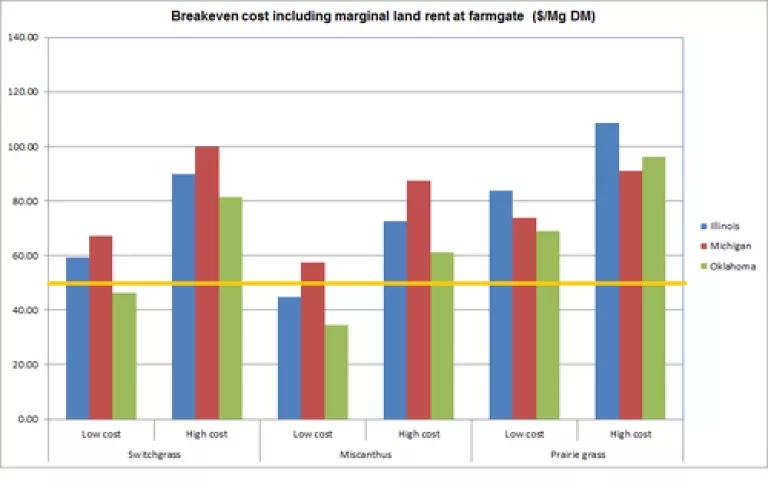Food prices are rising, exacerbated this summer by the worst U.S. drought since the 1930’s, which wrought havoc on corn crops across the Midwest. With 40% of U.S. corn production going to corn ethanol, calls to end biofuels mandates contained within the Renewable Fuels Standard (RFS) have mounted over concerns that crop-based biofuels create an untenable competition between our food and fuel needs, driving grain prices even higher.
While it’s tough to parse the exact impacts of biofuels mandates on corn—and, by extension, other grain prices—what’s clear is that in a complex global market for agricultural commodities, today’s biofuels make a bad situation worse.
The record food prices we seem on track to see over the next year are no isolated blip. Current events represent the third sharp increase in global grain prices in just half a decade. What we are seeing today are chronically tight agricultural commodity markets in which a growing global population, more meat consumption, and large and growing biofuels mandates each stake their claim to an ever larger share of a food supply strained by droughts and other extreme weather events around the world.
It’s critical that we move beyond corn ethanol and other food-based biofuels. More than ever, we need biofuels made from feedstocks that don’t take from our food supply and can be grown on lands not suitable for food production. Furthermore, these biofuels need to deliver on the promise of environmental benefits, including carbon emissions reductions and valuable ecosystem services that protect our soils, waters, and habitats.
While the bulk of biofuels that we see in the market today comes from corn, the goal of the RFS is overwhelmingly to encourage the development of these next-generation biofuels. Of the 36 billion gallons required under the RFS by 2022, 21 billion gallons are supposed to be so-called advanced biofuels that provide at least a 50% reduction in GHG emissions compared to gasoline. And of these 21 billion gallons, at least 16 billion are supposed to be cellulosic biofuels—made from non-food feestocks like crop residues, dedicated energy crops, and perennial grasses—and deliver at least a 60% emissions reduction.
But the RFS alone will not be enough to get us to the biofuels we need. To get those better biofuels, we will need tools outside the RFS to encourage farmers to grow better biomass.
At NRDC, we have proposed a Greener Biofuels Tax Credit, which would reward biofuel refineries for choosing environmentally preferable feedstocks—wastes, sustainably harvested cover crops, or perennial energy crops like switchgrass and willow—that require little land disturbance, fertilizer, or irrigation to grow, and so reduce carbon emissions. It would also reward refineries for purchasing biomass from farmers who actively manage their acres to reduce tillage, improve soil health, and minimize erosion and pollution runoff.
But making even a modest dent in our fossil fuel consumption will require significant biomass production, placing demands on land with consequences for farm income, food and feed production, and ecosystem services. To be economically sustainable, biomass must yield an income that exceeds a farmer’s costs of production, including foregone returns from alternative uses of land. If market prices, based solely on the energy content of different biomass feedstocks, are insufficient to make their production economically viable, government subsidies may be required while the industry develops.
A study sponsored by NRDC examined the profitability of growing energy crops in different U.S. regions, estimating the minimum or “breakeven” price a farmer in Illinois, Michigan, and Oklahoma would require to switch from the state’s most profitable cropping system to producing one of five biomass crops: corn stover, miscanthus, switchgrass, native prairie grasses, and poplar. Together with the market price of biomass, breakeven prices were used to determine the extent to which farmers in these states would need to be subsidized to produce biomass, both on marginal land and cropland.
Results show that energy crop production is significantly cheaper on marginal land than on cropland, suggesting that farmers are likelier to grow biomass on marginal lands, avoiding competition with food or feed production. If we want to see energy crops grown on cropland for environmental reasons—for example, to reduce soil erosion and nitrogen leaching and increase biodiversity—then subsidies would be required. At a biomass price of $50 per dry ton (DT), shown with a yellow line in the graph below, a farmer would need $12-$19 per DT in subsidies to grow a high yielding perennial like miscanthus when production costs are low, and $23-$52 per DT when they are high. Considerable subsidies ($19-$34 per DT) would be required to induce farmers to grow mixed grasses, even on marginal land and with low production costs.

For a full summary of results, see our new fact sheet here.
We can’t go on with business as usual without consequences for food prices—the most serious of which will be borne disproportionally by the most vulnerable communities in the world, which spend the greatest share of their incomes on food. But our cars, ships, airplanes, school buses, construction and farm equipment will all likely demand liquid fuels for years to come. That means we also can’t give up on the potential of a low-carbon and broadly sustainable liquid fuel alternative to oil. To get there will require understanding how to make sustainable biomass production economically sustainable for our farmers.



